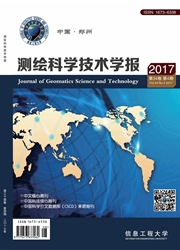

 中文摘要:
中文摘要:
陀螺寻北仪是一种精确、快速测定真北方位的仪器。主要特点是:定向精度高、测量时间短、在任何时间和地点(高纬度地区除外)都可以自主定向。然而,陀螺寻北仪易受异常因素影响,而使定向观测值产生异常。采用旋转调制方法,研究了以动凋陀螺为角速率传感器的全姿态寻北仪。为了削弱动调陀螺的噪声对寻北精度的影响,基于抗差估计原理构造了高崩溃污染率的初值辅以IGGⅢ方案迭代解算的混合算法。计算结果表明:基于可靠初值和稳定均方差因子估值的抗差估计可以有效削弱异常干扰的影响。测试结果显示,在4min之内系统的寻北精度优于1.5′,远高于最小二乘估计得到的精度。
 英文摘要:
英文摘要:
A gyro north seeker is a kind of instrument determining geographic azimuth fast and accurately. Its primary characteristics are high orientation accuracy, short orientation time and free orientation on any time and sites except high latitudes. However, gyro north seeker is easily influenced by abnormal factors that lead to singularities in orientation observations. Adopting rotation-modulation method, an all-attitude north seeker is studied, which employs dynamically tuned gyro as angular velocity sensor. A mixed iterative algorithm based on robust estimation principle is constructed to degrade influence of abnormal noises on precision of north seeker. It is with high breakdown point initial value and assisted by IGG m scheme. Calculations show that the algorithm based on reliable initial value and stable standard deviation factor can effectively degrade abnormal disturbances. Tests indicate that precision of north seeker excels 1.5′ in 4 minutes, which is much better than that of applying least squares estimation.
 同期刊论文项目
同期刊论文项目
 同项目期刊论文
同项目期刊论文
 期刊信息
期刊信息
